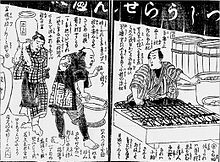
Tsujiura ( Japanese: 辻占) are notes used in Japan in conjunction with rice crackers called senbei in a similar way to fortune cookies. [1] Several publications make the claim that fortune cookies are derived from tsujiura senbei. [2] [3] [4]
References
- ^ Lee, Jennifer (2008). The Fortune Cookie Chronicles: Adventures in the World of Chinese Food. Grand Central Publishing. p. chapter 16. ISBN 9780446511704.
- ^ Lee, Jennifer (January 16, 2008). "Solving a Riddle Wrapped in a Mystery Inside a Cookie". The New York Times. Retrieved July 26, 2015.
- ^ Ono, Gary (2007-10-31). "Japanese American Fortune Cookie: A Taste of Fame or Fortune -- Part II". Archived from the original on 2007-11-02.
- ^ Nagata, Erik. "A Brief History of The Fortune Cookie". Archived from the original on 2008-08-20.

Tsujiura ( Japanese: 辻占) are notes used in Japan in conjunction with rice crackers called senbei in a similar way to fortune cookies. [1] Several publications make the claim that fortune cookies are derived from tsujiura senbei. [2] [3] [4]
References
- ^ Lee, Jennifer (2008). The Fortune Cookie Chronicles: Adventures in the World of Chinese Food. Grand Central Publishing. p. chapter 16. ISBN 9780446511704.
- ^ Lee, Jennifer (January 16, 2008). "Solving a Riddle Wrapped in a Mystery Inside a Cookie". The New York Times. Retrieved July 26, 2015.
- ^ Ono, Gary (2007-10-31). "Japanese American Fortune Cookie: A Taste of Fame or Fortune -- Part II". Archived from the original on 2007-11-02.
- ^ Nagata, Erik. "A Brief History of The Fortune Cookie". Archived from the original on 2008-08-20.